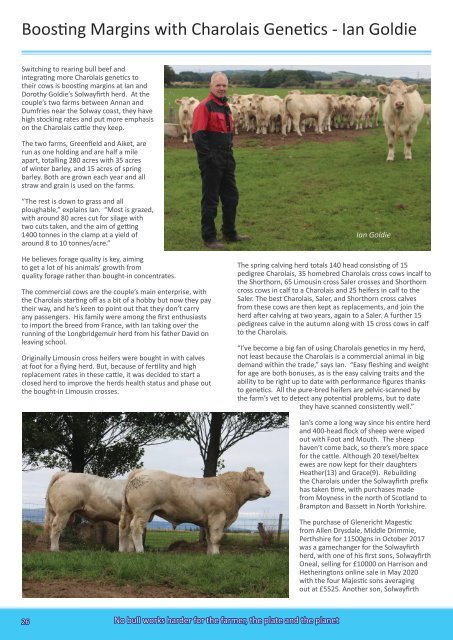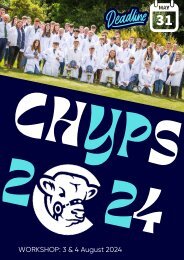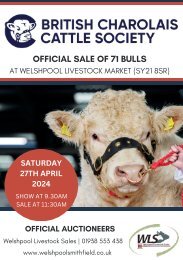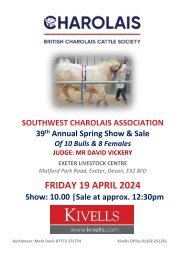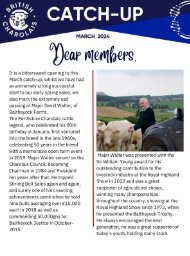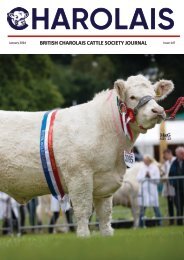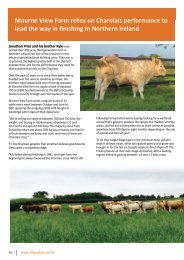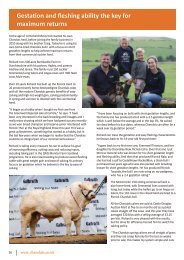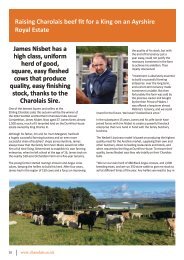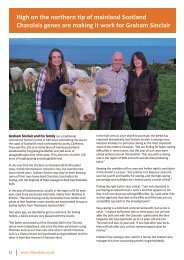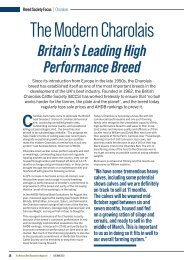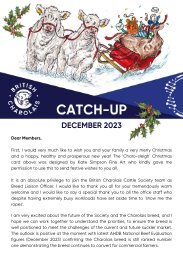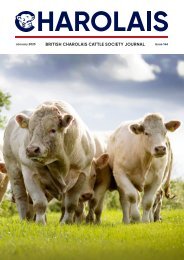You also want an ePaper? Increase the reach of your titles
YUMPU automatically turns print PDFs into web optimized ePapers that Google loves.
<strong>Boosting</strong> Margins <strong>with</strong> <strong>Charolais</strong> Genetics - Ian Goldie<br />
Switching to rearing bull beef and<br />
integrating more <strong>Charolais</strong> <strong>genetics</strong> to<br />
their cows is boosting <strong>margins</strong> at Ian and<br />
Dorothy Goldie’s Solwayfirth herd. At the<br />
couple’s two farms between Annan and<br />
Dumfries near the Solway coast, they have<br />
high stocking rates and put more emphasis<br />
on the <strong>Charolais</strong> cattle they keep.<br />
The two farms, Greenfield and Aiket, are<br />
run as one holding and are half a mile<br />
apart, totalling 280 acres <strong>with</strong> 35 acres<br />
of winter barley, and 15 acres of spring<br />
barley. Both are grown each year and all<br />
straw and grain is used on the farms.<br />
“The rest is down to grass and all<br />
ploughable,” explains Ian. “Most is grazed,<br />
<strong>with</strong> around 80 acres cut for silage <strong>with</strong><br />
two cuts taken, and the aim of getting<br />
1400 tonnes in the clamp at a yield of<br />
around 8 to 10 tonnes/acre.”<br />
He believes forage quality is key, aiming<br />
to get a lot of his animals’ growth from<br />
quality forage rather than bought-in concentrates.<br />
The commercial cows are the couple’s main enterprise, <strong>with</strong><br />
the <strong>Charolais</strong> starting off as a bit of a hobby but now they pay<br />
their way, and he’s keen to point out that they don’t carry<br />
any passengers. His family were among the first enthusiasts<br />
to import the breed from France, <strong>with</strong> Ian taking over the<br />
running of the Longbridgemuir herd from his father David on<br />
leaving school.<br />
Originally Limousin cross heifers were bought in <strong>with</strong> calves<br />
at foot for a flying herd. But, because of fertility and high<br />
replacement rates in these cattle, it was decided to start a<br />
closed herd to improve the herds health status and phase out<br />
the bought-in Limousin crosses.<br />
Ian Goldie<br />
The spring calving herd totals 140 head consisting of 15<br />
pedigree <strong>Charolais</strong>, 35 homebred <strong>Charolais</strong> cross cows incalf to<br />
the Shorthorn, 65 Limousin cross Saler crosses and Shorthorn<br />
cross cows in calf to a <strong>Charolais</strong> and 25 heifers in calf to the<br />
Saler. The best <strong>Charolais</strong>, Saler, and Shorthorn cross calves<br />
from these cows are then kept as replacements, and join the<br />
herd after calving at two years, again to a Saler. A further 15<br />
pedigrees calve in the autumn along <strong>with</strong> 15 cross cows in calf<br />
to the <strong>Charolais</strong>.<br />
“I’ve become a big fan of using <strong>Charolais</strong> <strong>genetics</strong> in my herd,<br />
not least because the <strong>Charolais</strong> is a commercial animal in big<br />
demand <strong>with</strong>in the trade,” says Ian. “Easy fleshing and weight<br />
for age are both bonuses, as is the easy calving traits and the<br />
ability to be right up to date <strong>with</strong> performance figures thanks<br />
to <strong>genetics</strong>. All the pure-bred heifers are pelvic-scanned by<br />
the farm’s vet to detect any potential problems, but to date<br />
they have scanned consistently well.”<br />
Ian’s come a long way since his entire herd<br />
and 400-head flock of sheep were wiped<br />
out <strong>with</strong> Foot and Mouth. The sheep<br />
haven’t come back, so there’s more space<br />
for the cattle. Although 20 texel/beltex<br />
ewes are now kept for their daughters<br />
Heather(13) and Grace(9). Rebuilding<br />
the <strong>Charolais</strong> under the Solwayfirth prefix<br />
has taken time, <strong>with</strong> purchases made<br />
from Moyness in the north of Scotland to<br />
Brampton and Bassett in North Yorkshire.<br />
The purchase of Glenericht Magestic<br />
from Allen Drysdale, Middle Drimmie,<br />
Perthshire for 11500gns in October 2017<br />
was a gamechanger for the Solwayfirth<br />
herd, <strong>with</strong> one of his first sons, Solwayfirth<br />
Oneal, selling for £10000 on Harrison and<br />
Hetheringtons online sale in May 2020<br />
<strong>with</strong> the four Majestic sons averaging<br />
out at £5525. Another son, Solwayfirth<br />
26<br />
No bull works harder for the farmer, the plate and the planet
Peterpan, sold for the second<br />
top price of 14000gns in<br />
February 2021 and a further<br />
two Majestic sons selling for<br />
7000gns each in May 2021.<br />
All the cows are housed from<br />
around the end of October on<br />
slats, and when they begin to<br />
calve around the 15 of April,<br />
they move outdoors to calve<br />
to prevent the calves picking<br />
up bugs which can build up<br />
indoors. A cow catcher was<br />
purchased several years ago,<br />
and this has made calving<br />
outside a lot easier - weather<br />
permitting.<br />
All cattle are fed a TMR diet, <strong>with</strong> the young bulls on a growing<br />
ration fed 1.5kg/dlwg. The ration includes their home-grown<br />
barley and a bought-in protein balancer. The in-calf cows are<br />
fed silage and minerals but the ration includes up to 4kgs of<br />
ground straw, depending on silage analysis, to prevent them<br />
from putting on too much weight pre-calving.<br />
“The <strong>Charolais</strong> are popular in the store ring and sell well,” he<br />
says, and aims to sell his steer calves and heifers not retained<br />
as herd replacements at 10-12 months old, weighing between<br />
380 and 400kgs. “We’ve decided to try something different,<br />
by rearing bulls, and so far, this is paying dividends. We<br />
finished about 30 this summer and have now left all male<br />
calves entire this year as we’ve found the margin is a lot<br />
better. We’re getting an average of £1650/head for the bull<br />
beef ranging between 14 and 15 months<br />
of age at slaughter, and 380 to 420kgs<br />
deadweight. This equates to about an<br />
extra £500 a head for keeping them an<br />
extra 16 weeks, although this is probably<br />
the most expensive period to keep them.<br />
We’re relying on a deadweight price of<br />
around £4.20/kg to get a decent margin.<br />
“Overall our aim is to breed easy-care,<br />
commercially viable females, and to<br />
move away from the dairy influence on<br />
the suckler cows. We want docile cows,<br />
ones that are a bit smaller but still have<br />
good pelvic space, are good milkers, carry<br />
flesh better and feed the calf well. The<br />
<strong>Charolais</strong> <strong>genetics</strong> certainly play a big, and<br />
ever-increasing, role in this.”<br />
No bull works harder for the farmer, the plate and the planet 27


